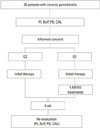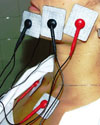1. Claffey N, Polyzois I. Lindhe J, Lang NP, Karring T, editors. Non-surgical therapy. Clinical periodontology and implant dentistry. 2009. Oxford: Blackwell Munksgaard;767–779.
2. Groeneveld MC, Everts V, Beertsen W. A quantitative enzyme histochemical analysis of the distribution of alkaline phosphatase activity in the periodontal ligament of the rat incisor. J Dent Res. 1993. 72:1344–1350.

3. Yoshimura N. Effects of electrical stimulation on periodontal tissue regeneration in dogs. J Kyushu Dent Soc. 1993. 47:590–606.

4. Cheng N, Van Hoof H, Bockx E, Hoogmartens MJ, Mulier JC, De Dijcker FJ, et al. The effects of electric currents on ATP generation, protein synthesis, and membrane transport of rat skin. Clin Orthop Relat Res. 1982. (171):264–272.
5. Bassett CA. Fundamental and practical aspects of therapeutic uses of pulsed electromagnetic fields (PEMFs). Crit Rev Biomed Eng. 1989. 17:451–529.
6. Bach S, Bilgrav K, Gottrup F, Jørgensen TE. The effect of electrical current on healing skin incision. An experimental study. Eur J Surg. 1991. 157:171–174.
7. Nessler JP, Mass DP. Direct-current electrical stimulation of tendon healing in vitro. Clin Orthop Relat Res. 1987. (217):303–312.

8. Carley PJ, Wainapel SF. Electrotherapy for acceleration of wound healing: low intensity direct current. Arch Phys Med Rehabil. 1985. 66:443–446.
9. Ciombor DM, Aaron RK. The role of electrical stimulation in bone repair. Foot Ankle Clin. 2005. 10:579–593. vii

10. Brighton CT, Friedenberg ZB, Mitchell EI, Booth RE. Treatment of nonunion with constant direct current. Clin Orthop Relat Res. 1977. (124):106–123.

11. Jacobs JD, Norton LA. Electrical stimulation of osteogenesis in pathological osseous defects. J Periodontol. 1976. 47:311–319.

12. Kaynak D, Meffert R, Günhan M, Günhan O. A histopathologic investigation on the effects of electrical stimulation on periodontal tissue regeneration in experimental bony defects in dogs. J Periodontol. 2005. 76:2194–2204.

13. Bruzek DB, Geistfeld NS. Clinical study to evaluate the use of electronic anesthesia during dental hygiene procedures. Northwest Dent. 1996. 75:21–26.
14. Reuter E, Krekeler G, Krainick JU, Thoden U, Doerr M. Pain suppression in the trigeminal region by means of transcutaneous nerve stimulation. Dtsch Zahnarztl Z. 1976. 31:274–276.
15. teDuits E, Goepferd S, Donly K, Pinkham J, Jakobsen J. The effectiveness of electronic dental anesthesia in children. Pediatr Dent. 1993. 15:191–196.
16. Oztaş N, Olmez A, Yel B. Clinical evaluation of transcutaneous electronic nerve stimulation for pain control during tooth preparation. Quintessence Int. 1997. 28:603–608.
17. Hargitai IA, Sherman RG, Strother JM. The effects of electrostimulation on parotid saliva flow: a pilot study. Oral Surg Oral Med Oral Pathol Oral Radiol Endod. 2005. 99:316–320.

18. Strietzel FP, Martín-Granizo R, Fedele S, Lo Russo L, Mignogna M, Reichart PA, et al. Electrostimulating device in the management of xerostomia. Oral Dis. 2007. 13:206–213.

19. Page RC, Eke PI. Case definitions for use in population-based surveillance of periodontitis. J Periodontol. 2007. 78:7 Suppl. 1387–1399.

20. Todd I, Clothier RH, Huggins ML, Patel N, Searle KC, Jeyarajah S, et al. Electrical stimulation of transforming growth factor-beta 1 secretion by human dermal fibroblasts and the U937 human monocytic cell line. Altern Lab Anim. 2001. 29:693–701.

21. Plemons J, Eden BD. Rose LF, Mealey BL, Genco RJ, editors. Nonsurgical therapy. Periodontics: medicine, surgery, and implants. 2004. St. Louis: Elsevier Mosby;237–262.
22. Claffey N, Egelberg J. Clinical indicators of probing attachment loss following initial periodontal treatment in advanced periodontitis patients. J Clin Periodontol. 1995. 22:690–696.

23. Claffey N, Polyzois I, Ziaka P. An overview of nonsurgical and surgical therapy. Periodontol 2000. 2004. 36:35–44.









 PDF
PDF ePub
ePub Citation
Citation Print
Print




 XML Download
XML Download